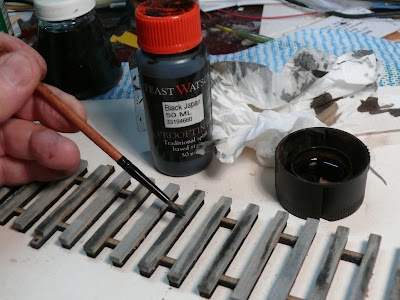Curved rail is prepared in advance as per the straight rail except it is curved to radius to fit its location. Preparing curved track work is not very different than building straight track work and does not require any special skills. The real difference is that the rail's needs to be curved. To ensure that the rail is properly pre-bent into shape consider purchasing a Fast Tracks Rail Roller.
The Fast Track Rail Roller tool will not only make it easy to create smooth consistent curves, but will also ensure that the rail is properly pre-bent so that it will retain its shape over time. For curves use track gauges to ensure smooth curved track work and is especially important at joints between individual sleeper bases.
Failure to properly pre-bend the rail for curved track work will result in failure over time!
Track Laying General.
Track Laying General.
After preparing the road base and ensuring it is 100% flat the time has come to install the track work. What will be outlined here is the basic technique applied to that task.
The golden rule is bad track work CANNOT be fixed...!
 |
| Curved Rail ready for Installation |
 |
| Drilling Tie Plates for Spikes |
Initially 0.020' [0.5 mm] drill was used but the pins just slipped into holes with little apparent holding power. The real issue was the short life and cost so another way had to be found. The answer was found in spring wire 0.020'' [0.5 mm] which was filed into a simple D bit by grinding 5 degree taper then form a point at the end. Using a small battery drill and chuck the wire drill cleanly through the sugar pine sleeper and ply base. In most cases the pins press in with a slight pressure were the pins fold up re-drill till success is achieved. These drills will bend to unbelievable angles without breaking and a length of piano wire will supply as many as any project would need. Another advantage is that the hole created appears to close up after the pin is inserted and develops excellent holding power.
 |
| D-BIT |
Another problem was found with the foam base - it dose not resist pressure well but it was found that a scale ruler spreads the load enough to overcome this problem. To make this task easier adhesive was not applied at at the edges of the sleeper base.
 |
| Spiking Rail |
In practice it has been found that the head of the pin should be bent from the normal axis to obtain a tighter fit. This is best done by drilling the hole at 5 degrees to the vertical. The pin is inserted until the spike pliers strikes the rail flange - using the pliers bend the head into the vertical and complete the insertion of the spike to the flange base
 |
| The Final Result |
At this point the track is ready for weathering and ballasting which will be covered in separate articles.
Is there a downside its the speed but a looking at the finished product you are reminded it is all worth while - I think...!










